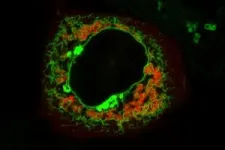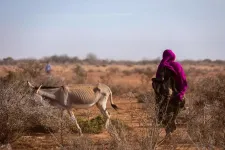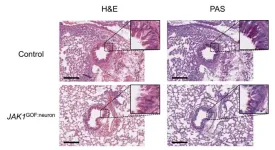(Press-News.org) Highlights
Messenger RNA (mRNA) is translated into proteins in the cytoplasm of cells. But rather than being a uniform “soup,” the cytoplasm is divided into multiple distinct compartments or regions.
Each region is largely responsible for translating functionally similar types of mRNA, a new MSK study finds. And the location of translation determines the amount of protein produced by the mRNA.
The movement of mRNA to specific regions is directed by their size and shape, as well as by RNA-binding protein partners.
The findings could help develop new approaches to increase or alter the production of proteins in mRNA therapies.
Back in 2018, the lab of Christine Mayr, MD, PhD, at Memorial Sloan Kettering Cancer Center (MSK) introduced the world to a key cellular component that had been hiding in plain sight.
Now the lab is back with important results that build on that discovery. New findings published in Molecular Cell provide details about the hidden organization of the cytoplasm — the soup of liquid, organelles, proteins, and other molecules inside a cell. The research shows it makes a big difference where in that cellular broth that messenger RNA (mRNA) get translated into proteins.
“You know the old real estate saying, ‘location, location, location.’ It turns out it applies to how proteins get made inside of cells, too,” says Dr. Mayr, a molecular and cell biologist at the Sloan Kettering Institute, a hub for basic and translational research within MSK. “If it’s translated over here, you get twice as much protein as if it’s translated over there.”
This first-of-its-kind study highlights the degree to which the cytoplasm is “beautifully organized,” rather than being just a big jumble of stuff, she says.
Not only do the findings shed new light on fundamental cellular biology, but the knowledge also holds promise for increasing or altering the production of proteins in mRNA vaccines and therapies, the researchers note.
The study was led by former lab member Ellen Horste, PhD, whom Mayr tapped for the daunting but exciting project when she joined the lab several years ago. Dr. Horste received her doctorate from the Gerstner Sloan Kettering Graduate School in June and now works for a gene therapy company.
“When we started, we had a hard time getting funding for this project,” Dr. Mayr says. “Everyone thought isolating the individual components would be totally impossible. This was really Ellen’s project from her first day in the lab to her last day. It was quite challenging, and I couldn’t be more proud of her.”
Adapting an approach commonly used by immunologists, the team was able to color-code individual particles within cells using antibodies and then sort them by color. They used RNA sequencing to identify which RNAs were associated with which particles.
“And it was really striking to see that in each of these intracellular neighborhoods, very different types of mRNAs were being translated,” Dr. Mayr says.
Welcome to the Cellular Neighborhood
Most of the well-known components inside a cell have a defined shape and come wrapped in an exterior membrane: the nucleus, mitochondria, lysosomes, the Golgi apparatus.
Two of the key components at the heart of the Mayr team’s study don’t have membranes — which is what has made them so hard to find in the first place, and a challenge to isolate and study in the lab.
A quick biology review: Cells build proteins using instructions encoded in DNA. Those DNA sequences are transcribed into mRNA inside the cell nucleus. These messenger RNA then move out into the cytoplasm where they are translated into a useful protein.
The new study demonstrated that where in the cytoplasm this translation step happens isn’t random, and that there’s an underlying logic or “code” that directs mRNAs to specific neighborhoods within the cell.
“The whole cytoplasm is nicely compartmentalized,” Dr. Mayr says. “We were able to demonstrate there is a code at work that’s based on the mRNA’s biophysical features — their size and shape — and the particular RNA-binding proteins they partner with. This code directs the mRNAs to different locations for translation.”
Investigating Translation in 3 Locations Inside the Cell
Through a painstaking series of experiments, the research team was able to show that mRNAs of different lengths and shapes tend to gravitate to specific neighborhoods. And that if you intervene to redirect them to a different location, it can have a profound impact on the amount of protein that gets produced and on the protein’s function.
The researchers looked at mRNAs that locate to the surface of the endoplasmic reticulum (an organelle involved in protein synthesis and other cellular functions). It’s well established that proteins associated with cellular membranes and those that get secreted by the cell for use elsewhere are translated there. The research revealed that nearly 15% of mRNAs that encode non-membrane proteins are also translated at the ER — and they encode large and highly expressed proteins.
Meanwhile, the mRNAs that get translated in the cytosol (the liquid part of the cytoplasm) tend to be very small proteins.
And mRNAs that locate to TIS granules tend to be transcription factors (proteins that regulate the transcription of genes). TIS granules are a membrane-less cellular component Mayr’s lab discovered in 2018. They form a network of interconnected proteins and mRNAs, and are closely allied with the endoplasmic reticulum, forming a distinct space where mRNA and proteins can collect and interact.
A fluorescent microscopy image of a cell, with TIS granules shown in red and the endoplasmic reticulum is shown in green. The central black area is the cell’s nucleus.
Cracking the Code
Cracking the code for how mRNA localize to different locations revealed some surprising findings.
After discovering the TIS granule network five years ago, the lab had turned its attention to understanding which of the many thousands of mRNAs in a cell localize there, and whether they have shared characteristics.
The team homed in on one part of the mRNA that doesn’t usually get much attention — the tail. It’s separate from the middle part of the mRNA, which contains the instructions for building the protein. Scientists call the tail the three prime untranslated region (3′ UTR), and it turns out to be critical for the localization process.
“The tail usually contains a longer sequence than the part of the RNA that’s actually used to make the protein,” Dr. Mayr says. “But for a long time, people didn’t pay that much attention to the tail regions since you can still make the protein without them.” (They’re also important in other ways, as Dr. Mayr outlined in a 2019 review article.)
It turns out that the tail is essential for partnering with RNA-binding proteins so that, together, the mRNA goes to the correct translation region within the cell. (RNA-binding proteins are a type of protein that attaches to RNA molecules and can modulate various aspects of their activity.)
At first the team thought it was primarily these RNA-binding proteins that directed the action — guiding the mRNAs to neighborhood one, neighborhood two, and so forth, Dr. Mayr says.
“But the really surprising finding was that the RNA-binding proteins actually play a secondary role rather than a primary role in the process,” she says.
The default sorting of mRNA to a location, the researchers found, is based on the overall size and shape of the mRNAs. But being in partnership with a binding protein can override this default and redirect them.
“Our data show that if you translate an mRNA in the TIS granules, the resulting protein will perform one function, and if you translate it outside of the TIS granules, it will perform a different function,” she says. “And this is how, in higher organisms like us, one protein can have more than one function.”
Toward Future Applications
One specific protein the team examined during the study is MYC. The MYC gene is one of the more famous oncogenes, and mutations in MYC underlie the development of many cancers.
“We observed that several MYC protein complexes were only formed when MYC mRNA was translated in the granules and not when it was translated in the cytosol,” Dr. Mayr says. “Our results show there’s an important biological relevance to these neighborhoods, even when only about 20% of mRNAs get translated in the TIS granules.”
Together, these insights suggest that mRNA could be targeted to achieve different functions, as well as to vary the amount of a protein that gets produced, she adds.
“So, we hope that in the future we can make smarter medicines by making more or less of a particular factor, and also by manipulating its function,” Dr. Mayr says. “This probably won’t happen in the next five years, but it’s something we are paving the way to do.”
Additional Authors, Funding, and Disclosures
Additional authors include Mervin M. Fansler, Ting Cai, Xiuzhen Chen, Sibylle Mitschka, and Gang Zhen of MSK. And Flora C. Y. Lee and Jernej Ule of King’s College London and the Francis Crick Institute.
The work was funded by the National Institutes of Health (DP1-GM123454, R35GM144046, CA254335-01) MSK’s Core Grant from the National Cancer Institute (P30 CA008748), the Pershing Square Sohn Cancer Research Alliance, and the G. Harold and Leila Y. Mathers Foundation. Authors also received funding from the European Union Horizon 2020 Research and Innovation Program, and The Francis Crick Institute — which receives its core funding from Cancer Research UK (CC0102), the U.K. Medical Research Council (CC0102), and the Wellcome Trust (CC0102).
The authors declare no competing interests.
Read the Article: “Subcytoplasmic location of translation controls protein output,” Molecular Cell. DOI: 10.1016/j.molcel.2023.11.025.
END
Location, location, location: The hidden power of intracellular neighborhoods
2023-12-21
ELSE PRESS RELEASES FROM THIS DATE:
Better prosthetics: $3M to develop more natural robotic leg control
2023-12-21
Dec. 21, 2023
Contact: Nicole Casal Moore, 734-709-1651, ncmoore@umich.edu
Images and videos
Better prosthetics: $3M to develop more natural robotic leg control
An effort to create a control model that moves seamlessly between different activities like standing, walking and climbing stairs is renewed by the National Institutes of Health
ANN ARBOR—A smoother experience for robotic prosthetic leg users is the aim of a University of Michigan project that has received renewed support from the National Institutes of Health. The R01 grant ...
The Council of Medical Specialty Societies awards CHEST a $100,000 grant to improve diagnostic excellence in ILD
2023-12-21
Glenview, IL – The American College of Chest Physicians (CHEST) was awarded a $100,000 grant from the Council of Medical Specialty Societies (CMSS) to improve diagnostic excellence in interstitial lung disease (ILD).
The funded project, called, "'How We Do It': CHEST Experts Weigh In," aims to inform future best practices in reducing the time to diagnosis for ILDs. The activities in the series will prepare the learner to:
define symptoms and patient profiles associated with ILD;
recognize health inequities that may assist in the diagnosis of ILD;
identify the appropriate tests that may help validate a suspicion of ILD; ...
Center for BrainHealth investigates the impact of auditory beat stimulation on cognition
2023-12-21
Certain Frequencies Enhance Comprehension
New research conducted by the Center for BrainHealth at The University of Texas at Dallas investigates the impact of binaural beat (BB) on language skills. BB is a sound that occurs when two slightly mismatched pure tones are heard. There is a growing interest in using BB as a non-invasive neuromodulation to enhance cognitive performance.
The study, Neural consequences of binaural beat stimulation on auditory sentence comprehension: an EEG study, was recently published in Cerebral Cortex.
Led by researchers in the Speech, Language and Music (SLAM) Lab, this EEG ...
Where you live matters: A first-of-its-kind study illustrates how racism is interrelated with poor health
2023-12-21
Where You Live Matters: A First-of-Its-Kind Study Illustrates How Racism Is Interrelated With Poor Health
Study published in JAMA Network Open points to discrete factors, like voting participation, employment, education, and housing, that may serve as promising targets for interventions
New York, NY (December 21, 2023) – A team of health equity researchers from several institutions has leveraged a complex web of data to test a hypothesis: That structural racism is associated with resources and structures at the neighborhood level that are closely associated with poor health. What they found in an analysis of highly localized, ...
New tool unifies single-cell data
2023-12-21
A new methodology that allows for the categorisation and organisation of single-cell data has been launched. It can be used to create a harmonised dataset for the study of human health and disease.
Researchers at the Wellcome Sanger Institute, the University of Cambridge, EMBL’s European Bioinformatics Institute (EMBL-EBI), and collaborators developed the tool, known as CellHint. CellHint uses machine learning to unify data produced across the world, allowing it to be accessed by the wider research community, potentially driving new discoveries.
In a new study, ...
Pancake stack of films on a balloon most accurate gamma-ray telescope
2023-12-21
A pancake stack of radioactivity-sensitive films carried through the sky by a balloon was able to take the world's most accurate picture of a neutron star's gamma ray beam. To achieve this, Kobe University researchers combined the oldest method of capturing radioactive radiation with the newest data capturing techniques and a clever time-recording device.
The stars shine their light on us in the full range of the spectrum of light, from infra-red to gamma rays. For each of these bands, different sensing equipment is needed. The most challenging one is gamma rays, famous for being a high-energy product of nuclear fission, ...
Wireless tracking system could help improve the XR experience
2023-12-21
A new technology developed by engineers at the University of California San Diego has the potential to make the extended reality (XR) experience smoother and more seamless. The technology consists of an asset localization system that uses wireless signals to track physical objects with centimeter-level accuracy in real time, and then generates a virtual representation of these objects. Applications of this technology range from enhancing virtual gaming experiences to improving workplace safety.
The team, led by Dinesh Bharadia, a professor in the Department of Electrical and Computer Engineering at the UC San Diego Jacobs School of Engineering, ...
Fleeing drought, vulnerable populations face flood risk in most African countries
2023-12-21
American Geophysical Union
Press Release 23-47
21 December 2023
For Immediate Release
This press release is also available online at: https://news.agu.org/press-release/fleeing-drought-vulnerable-populations-face-flood-risk-in-most-african-countries
AGU press contact:
Liza Lester, +1 (202) 777-7494, news@agu.org (UTC-5 hours)
Contact information for the researchers:
Serena Ceola, University of Bologna, serena.ceola@unibo.it (GMT+1 hours)
WASHINGTON — In 80% of African countries, moved toward rivers and into cities during or following drought, increasing the number of people living in flood-risk areas in ...
The future of canine stem cell therapy: unprecedented, painless, and feeder-free
2023-12-21
Osaka, Japan – Dog owners may need to learn to appreciate their best friend’s urine. Scientists at Osaka Metropolitan University have devised an efficient, non-invasive, and pain-free method to reprogram canine stem cells from urine samples, bringing furry companions one step closer to veterinary regenerative treatment.
Induced pluripotent stem cells (iPSCs) have been widely employed in studies on human generative medicine. With the growing importance of advanced medical care for dogs and cats, there is an expectation that new therapies utilizing iPSCs will ...
New insights revealed on tissue-dependent roles of JAK signaling in inflammation
2023-12-21
Researchers at the Icahn School of Medicine at Mount Sinai have gained a deeper understanding of the nuanced roles of JAK inhibitors, or modulators, in inflammation across various cell types and tissues. Their findings suggest a more precise approach is required to potentially expand JAK inhibitor use to a wider range of allergy and inflammatory disorders. Details on the findings were published in the December 21, 2023, issue of the journal Cell.
JAK1 is a key protein in the body that supports cell communication and controls the immune system. It is part of ...





